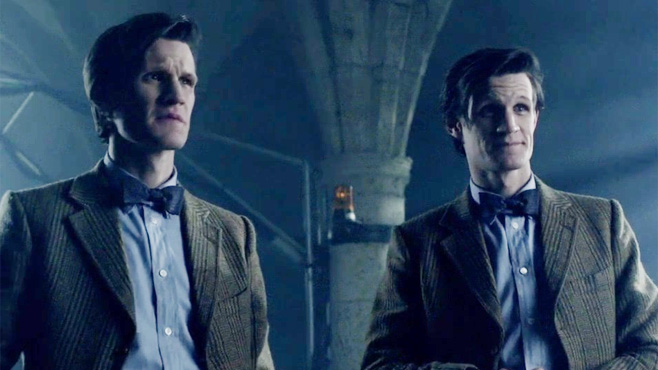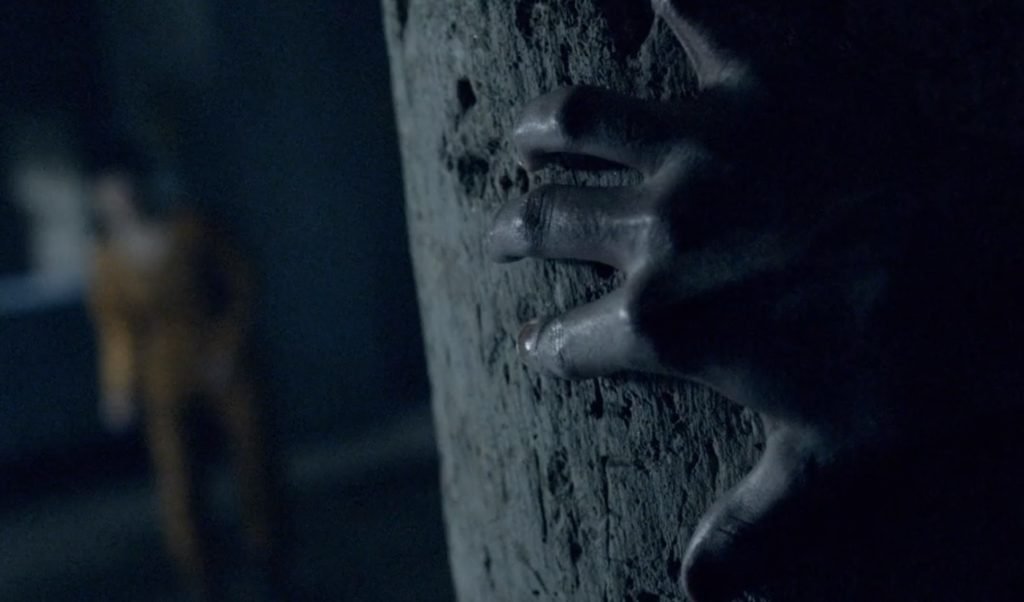Doctor Who is such an expansive show. It covers so many subjects and has millions of unique ideas and concepts. Some of these stay with us for all the right reasons, and others for all the wrong. The Rebel Flesh / The Almost People is a Series Six two-parter that, in fandom, often falls into the latter. (Thankfully, it still gets more credit than writer Matthew Graham’s previous attempt: Fear Her.)
The story is often dismissed as mediocre, or sometimes even outright bad. But wonder has to wonder why? It’s got an inventive creature at the heart of it. One that can be – and is – utilised for both scare factor and interesting moral quandaries. The story has quite an enjoyable mix of unusual scares, surprising twists and a genuinely fascinating examination of the morals & ethics regarding its subject matter.
What’s odd to consider is that it seems to largely be the case that people either don’t remember it or don’t rate it too high. Compared to some of the other amazing episodes in NuWho, it’s perhaps understandable. Fan ratings often become a matter of relativity. And perhaps that’s the trouble. It’s true, there are better stories but this one deserves so much more love than it gets. It’s a slow burner with more of a character-focus (one that the entire cast gets to really play with!) but it’s also a genius mashup of The Thing and Avatar.

Story Recap
The plot of this two-parter revolves around the Doctor, Amy and Rory visiting an acid factory in Earth’s 22nd century. The workers of this factory have been using “programmable matter,” known as The Flesh to create doppelgängers, or Gangers. This means they can send their clones into the factory, while they stay at a distance. Hooked up to machines, the humans can control their Gangers doing the dangerous work.
When the TARDIS crew find this factory in the middle of a solar storm, it breaks the machines and severs the Gangers from their humans. With some form of freedom, the Gangers begin to demand equality and a life of their own, and are willing to fight for it. Throughout the following story; we follow the gang as they try to liaise between the groups and come to some sort of conclusion, while also trying to work out who are the originals and who are the clones.
The TARDIS is gone, the Gangers grow more dangerous. As they develop more independence, some are influenced by the Gangers who hold extreme views on how they should fight for freedom. Jennifer manipulates and twists the separated TARDIS crew to her advantage, and things only get more complicated when a Doctor Ganger turns up too.

Why Is The Rebel Flesh / The Almost People So Good?
The Rebel Flesh / The Almost People is a great story for many reasons. It’s big, bold and ambitious. It’s a story that takes inspiration from multiple horror sources. And it’s not hiding that with the gothic horror of its monastery setting. The body horror in the grotesque ways that the Gangers sometimes look and move. Above all else though, it’s the use of psychological horror that really works in this story. In a twist inspired by The Thing, we are with the characters. Oblivious to who is “real” or who is Ganger. Throughout, lighting and cinematography riff on the horror genre to perfect strengths.
It inspires a fascinating conversation about the morals and ethics of cloning and what it means to be human. It pushes these topics even further into the territory of bodily autonomy for the Gangers. It’s science fiction but it’s also relevant to real life. Cloning is already a real thing, and as we take strides towards the future, it’s likely to be something that we will see more of.
What does it mean to be a clone? This story explores that concept. Taking in the matter of what that means in terms of identity for the original. What to do with clones if the original dies…? How does a clone share a family with the original when they both feel equal ownership…? And if cloning becomes doable en masse for dangerous environments, are we willing to see that organic matter – and version of ourselves – potentially die painfully? Do we suddenly redefine how we envision life and death when death is given the separation of a different body?
Aside from all of this, it’s a story that plays a vital part in the larger arc of the sixth series. We learn about the Flesh, later to become important when we discover that Amy has been taken away and replaced with a Ganger of herself. We also get another glimpse of Madame Kovarian, teeing up for further down the line as we edge ever closer to what the Silence and the Kovarian Chapter have lying in wait. So much hinges on this story and it carries the weight of setting up vital events later. But it’s not afraid to be much more than just a set-up for a doppelganger creature concept. Rather than just lying that down gently – it picks it up and continues to turn it around. Examining that concept for new details and nuances.

Final Thoughts on The Rebel Flesh / The Almost People
There are so many beautiful character moments in this story. The conversation with Rory and Ganger Jennifer is a beautiful scene. There’s another stunning scene where a character receives a video call from his son and the quiet humanity of the scene is beautiful.(Your humble assistant editor Jamie would like to concur with this, and also again emphasise how the guest cast – particularly Mark Bonnar – rises to the challenge of playing the emotions and empathy of the same person in two subtly different variants.)
There are a few things that perhaps let it down. The CGI, can, at times, leave a lot to be desired. But one might argue that is partly itself a retrospectively-held criticism. If we consider the TV budget of the show and the CGI capabilities of 2011, it perhaps would soften our feelings on it.
And though the story occasionally falls flat on the execution of all the exploration… admittedly, it’s a lot to handle within the time available. You could probably get an entire series out of this.(Assistant editor again: it is also perhaps very telling that after this story – this era will return to these matters of identity in The Day of the Doctor and The Zygon Invasion / The Zygon Inversion. This story paves the way and provokes those later thoughts, in my opinion.) We shouldn’t be too harsh on it for that because for a TV budget, it wasn’t that bad considering the scale of ambition.
Overall, I would say that this is one story that deserves a rewatch. Perhaps it won’t magically spike up people’s episode rankings, in-fact it probably won’t… But going in with an open mind? Thinking about this one again to appreciate everything it has to offer? Well, we’d recommend trying that. And so would our Gangers.
More From Nerdgazm
🚨 – The new Doctor Who: The Collection release – Season 9!
🔥 – An Exclusive Whoniverse Chat With Short Trips writers, Angus Dunican & Felicia Barker!
🧾 – Upcoming Star Wars: The High Republic projects in 2023!
You can also Follow Nerdgazm on Twitter, Find us on Facebook & Check out our Instagram!







